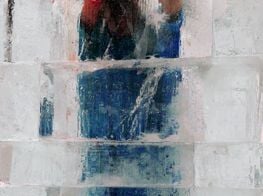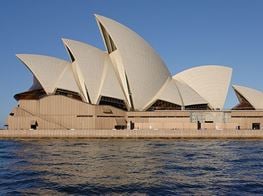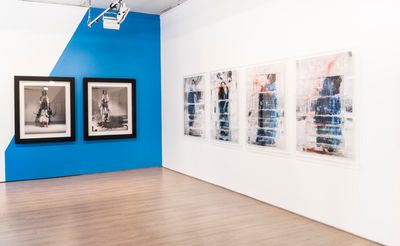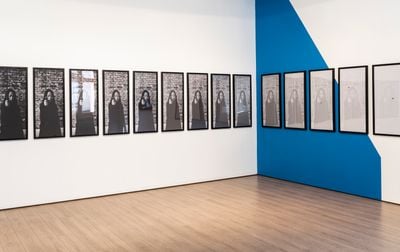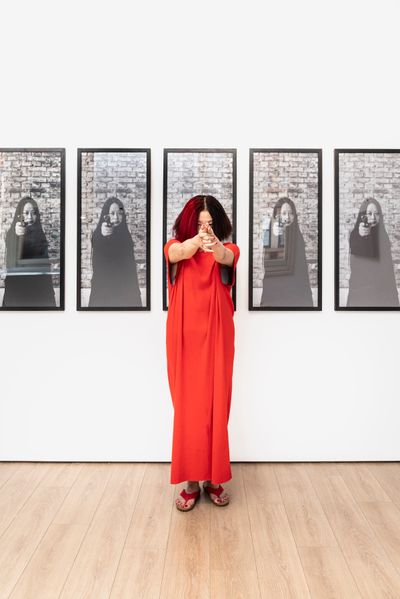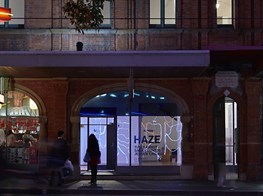Xiao Lu
In partnership with 4A Centre for Contemporary Asian Art
Xiao Lu, Polar 极地 (2016) (detail). C-type prints. Editions 1/9; 5/9. 80 x 120cm. Printed documentation of performance: Beijing Live 1, Danish Cultural Center, 798 Arts District, Beijing, China (23 October 2016). Photographs by Yi Zhilei. Exhibition view: Xiao Lu: Impossible Dialogue, 4A Centre for Contemporary Asian Art, Sydney (19 January–24 March 2019). Courtesy the artist. Photo: Kai Wasikowski (2019), for 4A Center for Contemporary Asian Art.

Xiao Lu, Polar 极地 (2016) (detail). C-type prints. Editions 1/9; 5/9. 80 x 120cm. Printed documentation of performance: Beijing Live 1, Danish Cultural Center, 798 Arts District, Beijing, China (23 October 2016). Photographs by Yi Zhilei. Exhibition view: Xiao Lu: Impossible Dialogue, 4A Centre for Contemporary Asian Art, Sydney (19 January–24 March 2019). Courtesy the artist. Photo: Kai Wasikowski (2019), for 4A Center for Contemporary Asian Art.
In the hot heat of the moment, history is sometimes only recorded in snippets. In the flurry to understand, information is conflated, building a historical account that never quite captures the reality of the moment. In 1989, Chinese artist Xiao Lu fired a handgun into her installation Dialogue displayed in the China/Avant-Garde exhibition, the milestone survey of contemporary Chinese art held at the National Art Museum of China in Beijing. This performative moment was recorded as a collaborative work between Xiao Lu and her then partner Tang Song. Fifteen years ago, impelled by her separation, she sought to reclaim Dialogue and argue for her place and her voice in the canon of contemporary Chinese art.
Accompanying her revision and righting of history, Xiao Lu has continued to create powerful and evocative statements on the precariousness of life. Her works are meticulously planned but unpredictable in their outcome; performances proceed like scientific experiments testing hypotheses. In Sperm (2006) she sought anonymous sperm donors with a series of glass vials and a freezer, in Polar (2016) she attempted to cut herself out of a giant ice prison with only a knife, and in her upcoming performance Tides (2019), the artist will take 30 bamboo poles, marking one year each, and attempt to place them in the sand of a Sydney beach during high tide. Through her performances, Xiao Lu inhabits her emotions and embraces them in compelling and vulnerable gestures. This submission to her own raw emotions is central to her practice and retains the potency of Dialogue's gunshots.
Part of the programme of events and exhibitions taking place over the Sydney Festival (9–27 January 2019), and 30 years after Dialogue and 15 years since Xiao Lu began to rewrite her own history, the artist presents Xiao Lu: Impossible Dialogue (19 January–24 March 2019) at 4A Centre for Contemporary Asian Art. Curated by art historians and curators Claire Roberts and Xu Hong, the exhibition is the culmination of a series of conversations and extensive research. In 2006, Beijing-based Xu Hong recognised Xiao Lu's need to rephrase history publishing an article that acknowledged Dialogue as solely Xiao Lu's work and, provocatively, pondered the art world's inability to recognise, let alone celebrate, radical art created by a woman. At the University of Melbourne, Claire Roberts has been conducting research into the performance, which has been the foundation for the first institutional survey of Xiao Lu's work at 4A Centre for Contemporary Asian Art.
For Xiao Lu, this exhibition, like her practice, is incredibly personal. Her steadfast vision and unwavering ability to delve into the depths of her spirit and allow her emotions to occupy her is at the core of Xiao Lu: Impossible Dialogue. Bringing together critical archival documentation of the China/Avant-Garde exhibition alongside performance documentation from the last 15 years, the exhibition enables viewers, for the first time, to appreciate Xiao Lu's rigorously persistent practice as an ongoing examination of her own life force.
MT5 February 2019 will mark 30 years since Dialogue, how are you marking this passage of time?
XLThe 30 years between 1989 and 2019 have passed in a flash. When you are younger you always look towards to future, to what is next, but you rarely look back. In 2003 I made the decision to look back and to face my audience; for the past 15 years since Dialogue I had my back to the audience but now I want to meet their gaze. I felt that I must face their scrutiny, face the repercussions of those 1989 gunshots and face the past 15 years. 15 gunshots... from 1989 to 2003 is an artistic and personal turning point, a marker that divides the time from when I looked forward to when I looked backwards. The 15 years since 2003 have been a fraught and challenging period as I have sought to sift through my memories, examine my relationships and write my own history. My novel Dialogue emerged through this process, it was something I had to write, I had to speak for myself about the years since 1989. In the exhibition at 4A Centre for Contemporary Asian Art, this divide is marked by the movement from the ground floor gallery that looks at Dialogue and the 1989 China/Avant-Garde exhibition in which it was exhibited in 1989, to the upstairs gallery that features 15 Gunshots... from 1989 to 2003 and a curated selection of my more recent works. The past 30 years are divided between two distinct periods: the loss of the first 15 years and the awakening in the second. I feel like it has been a period of rebirth.
MTHow does it feel to have these works exhibited side by side after all this time?
XLI feel that everyone—in China and internationally—knows me by the work Dialogue and my involvement in the China/Avant-Garde exhibition of 1989 but they don't know about my work since. At 4A, 1989 is a starting point but there is a focus on my more recent bodies of work, which sit together for the first time. This is the first time my work has been presented in an academic retrospective that goes beyond Dialogue.
MTCan you speak to how your art practice is a part of your daily life? Is performance a daily ritual for you or is it something more distinct and focused?
XLThe relationship between art and life is sometimes ambiguous. You are lucky if you can express yourself artistically in our society. Once, when I was at university, I asked the Bulgarian artist Maryn Varbanov what art is. He responded that art is to use all means possible to express the core of yourself. At the time I did not fully understand or comprehend this sentiment but over the years I have found this one sentence to be deeply influential. Whenever I am in the process of developing a new work, I feel that it comes from my heart and that the essence of my soul is encapsulated in my art. As such, performance art has always been my artistic medium of choice as it enables me to make this internal connection and express myself fully. It is more direct, sporadic, and uncertain than any other artistic medium and I like to work at the juncture between emotional control and loss of control. This requires a certain level of sensitivity and vulnerability and I never repeat performances; each performance is a new challenge and adventure where anything can happen. My work is driven by curiosity and excitement of the unknown and for each performance I submit myself to the moment and lay myself bare.
MTFifteen Gunshots .... from 1989 to 2003 is a powerful and critical work. It is a photographic series in which the bullet holes designate the remnants of a performance. It marks a clear juncture point where you actively sought to address your history—was the experience of creating it cathartic?
XLYes, it is a kind of catharsis, in fact this performance was particularly exhilarating. I once joked that if an ordinary person was unable to vent their extreme emotions then they might actually take a gun and kill someone. But artists have the ability to funnel these emotions and transform them into artwork.
MTYou have some reoccurring visual motifs in your work, namely the use of the colours blue and red, a distinct angle that you sometimes physically engage with in performance and, of course, your body, which always appears in punishing durational duress. Why do you return to these motifs?
XLI have an infatuation with the colour blue. Recently I bought a blue jeep, and began a love affair with the colour and, of course, with its corresponding red. Blue and red is my favourite combination. I have noticed, sometimes intentionally and sometimes unintentionally, that these colours often appear in my life—in my hair and my clothes. I never know what is going to happen in my works and when I performed Polar (2016) my hair was already dyed half red and blue and while I chose my blue dress I could not have predicted that blood was going to be the result of my work so it is a coincidence that it was red and blue. It was more of a conscious decision when I did the work Holy Water (2017), I even had my nails painted both blue and red.
The symbolism of the tilted angle is more personal and more connected with my own psychology. It encapsulates the ups and downs of my life and the perpetual search for balance when imbalance is the norm. The precariousness of imbalance is something I am always investigating, it appears often in my work.
Over time, performance art has become my main expression and what I am known for. I don't like to repeat work, so each performance is new and contains unknowable factors. When I look back on my own work, the experience of each piece is connected to specific contexts that are, for me, memories of my life experiences.
MTYour recent performance work examines ideas of extreme action, whereby you push your emotions to the edge and create space for precariousness. There is always a sense of exhilaration and then a collapse, why do you push yourself to these limits?
XLWith collaboration, the aim is to establish a foundation of mutual respect. Whether the performance ends up being good or bad, that is the responsibility of the artist. I can understand the worry of curators due to the uncertainty built in to my works. I hope that with future collaborations I can learn more about those I collaborate with, so that we can better understand and trust each other.
Have you felt that your practice has been supported overall? Have there been critical people or places that have helped your work gain visibility and pushed you to continue to practice?
Performance art remains marginalised in contemporary art circles. In May 2018 I was invited to exhibit Dialogue at the Tate Modern in London as part of the exhibition Performer and Participant, their first thematic exhibition that examined international performance art. I was introduced there as the first female Chinese performance artist and I was wary of this label as I have sought to hard to move beyond 1989. The Tate curator, Sook-Kyung Lee, reassured me that if I wasn't still practicing, then Dialogue would not have been considered for the exhibition. This was important for me as it recognised the historical importance of Dialogue but it affirmed my practice as a whole and the work I continue to do.
Performance art is a challenge as it is rare that it is collected into institutional collections, so when you have support from places like the Tate or 4A it is important. At 4A, with the support of Claire Roberts and yourself, I will have my first catalogue and they have conducted extensive research about my work. Claire has travelled across China to interview different people, to piece stories together and this is the first time I have had this attention and been supported by an institution in an academic way. I left Australia 22 years ago but now, with this exhibition, I am beginning to think about returning. Having this solo exhibition at 4A indicates to me that there are possibilities of expanding my practice in Australia.
You mention that it has taken time for your work to be examined by curators and academics. Why do you think this is?
Although I made my name in 1989, I stopped practicing for a long time. Since 2003, I have returned to my art practice and produced some works. It has been 30 years since 1989—I think it is a good opportunity to do a considered academic examination and presentation. —[O]
—
This English version is based on Xiao Lu's responses in Mandarin and has been translated by Shuxia Chen and Mikala Tai.

